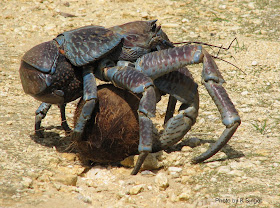"What’s methyl farnesoate got to do, got to do with it?
What’s methyl farnesoate got to do, got to do with it?
Wow, that's a good question Tina (or three, really). I'm surprised you're so familiar with crustacean hormones, but I guess I should never underestimate Ms. Turner.
mm-hmm!
Well, now that I've been set straight, let me answer your big question: what does methyl farnesoate (MF) have to do with crab love? That is the big question in my graduate thesis, and I'm afraid I don't have all the answers... YET. But here's what I do know:
You'll remember that MF is synthesized in the mandibular organs (MO):
methyl farnesoate leaving the mandibular organs and heading for the gonads
When the MF leaves the MOs (ah, science and acronyms), it binds to specific receptor sites that can change the physiological activity of the target (such as the gonads). What results is increased gonad development, so far recorded in these crustaceans:
monsoon river prawn Macrobrachium malcolmsonii (pictured is a congener)
and red swamp crayfish Procambarus clarkii
green crab Carcinus maenas,
Indian field crab Oziotelphusa senex senex (another congener picture),
and spider crab Libinia emarginata
In the red swamp crayfish, green crab, spider crab, and Tanner crab (you remember Chionoecetes bairdi), higher MF also correlates with more reproductive behavior. And, since MF stimulates secretion of ecdysteroids by the Y-organs (which in turn stimulates the production of a new shell and shedding of the old one), mating and molting are hormonally linked!
MF stimulating the secretion of 20-hydroxyecdysone (20-HE) from the Y-organs
My research will look at the mating/molting relationship in snow crabs: will MF be lower in post-molt males? Will it correlate with lower gonads (GSI)? I can't wait to find out!
So you see, Tina, MF has a lot to do, lot to do with it!


















































